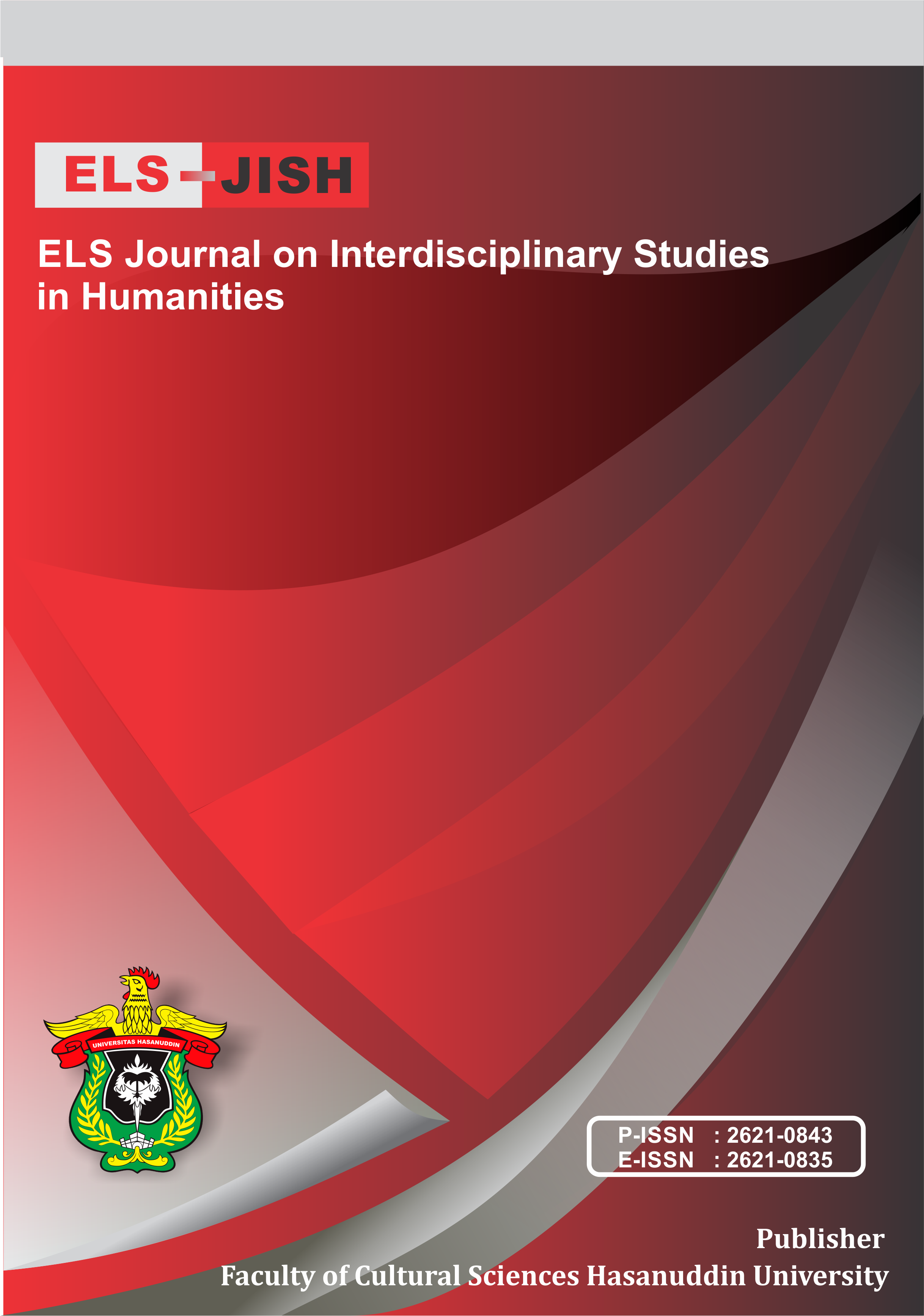The Significances of Signs in Local Riddle of Toraja
Keywords:
Karume, Riddle, Significance, SignsAbstract
Many forms of language can be used to measure our thinking ability. The different area has different way in communicating language. Karume or riddle is a language model that contains many signs, it is worthy to be preserved for the sake of cognition and creativity thinking of Toraja’s Millennium generation. This research aims to find the significances of local riddle, called karume, by using de Saussure’s theory that elaborates the idea of signifier, signified, and significance. For the further analysis, this research also investigates meaning of signs either denotatively or connotatively, the data then analyzed by combining both word-level analysis and sentence level analysis. The method used in this research was a descriptive qualitative method. To obtain the data, the documentation technique was used. Firstly, the data downloaded from internet then translated lexically and contextually to get the cores that facilitated signifier and signified. In simplifying data analysis, the data was classified based on its forms and then put into a table and then the data analyzed structurally and denotatively-connotatively. The Result of this analysis revealed that there were three features of semiotics embodied in karume. They were 1. Analogy, 2. Language style, and 3. Entailment. They can be used to show referential significance of riddle in Toraja
References
Ayer, A.J. (1952). Language, Trurh, and Logic. Dover Publication Inc. New York.
Bertens, K. (1981). Filsafat Barat dalam Abad XX. Gramedia. Jakarta.
Braz, R.S. (2005) An Inference Model for Semantic Entailment in Natural Language. Urbana: University of Illinois at Urbana-Champaign.
Coblay, P., & Jansz, L. (1999). Introducing Semiotics. New York: Icon Books-Totem Books.
Grenz, S. J. (2001). A Primer on Postmodernism: (Pengantar untuk Memahami Postmodernism). Penerjemah: Wilson Suwanto. Yayasan Andi. Yogyakarta.
Kaelan. (2017). Filsafat Bahasa Semiotika dan Hermeneutika. Yogyakarta: Paradigma.
Keraf, G. (2010). Diksi dan Gaya Bahasa. Jakarta: PT Gramedia.
Kridalaksana, H. (1982). Kamus Linguuistik. Jakarta: PT Gramedia.
Kristayulita, As’Ari, A.R, & Sa’dijah, C. (2017). Masalah Analogi: Kajian Teoritik Skema Penalaran Analaogi. Jurnal SI MaNIs (Seminar Intehrasi Matematika dan Nilai Islami) Vol.1,No1, Juli 2017, Hal 435-441.
Kurniawan. (2001). Semiologi Roland Barthes. Magelang: Yayasan Indonesiatera..
Kusuma, N., & Nurhayati, I. (2017). Analisis Semiotika Roland Barthes pada Ritual Otanan di Bali. Jurnal Manajemen Komunikasi, 1(2), pp: 195-21.
Mansyur, F. A., & Suherman, L. A. (2020). The Function of Proverbs as Educational Media: Anthropological Linguistics on Wolio Proverbs. ELS Journal on Interdisciplinary Studies in Humanities, 3(2), 271-286.
Pateda, M. (1987). Sosiolinguistik. Bandung: Angkasa.
Putri, K & Nadjib, M. (2015). Semiotika Pesan Instagram Ani Yudhoyono dalam Perspektif Etika Komunikasi. Jurnal Komunikasi KAREBA, 4 (1).
Rahman, F., & Letlora, P. S. (2018). Cultural Preservation: Rediscovering the Endangered Oral Tradition of Maluku (A Case Study on Kapata of Central Maluku). Advances in language and literary studies, 9(2), 91-97.
Rahman, F., & Weda, S. (2019). Linguistic deviation and the rhetoric figures in Shakespeare’s selected plays. XLinguage" European Scientific Language Journal", 12(1), 37-52.
Sahib, H., Rahman, F., Duli, A., & Asba, A. R. (2019, May). Customary Forest Conservation through Informal Knowledge System of Ammatowa Community. In IOP Conference Series: Earth and Environmental Science (Vol. 270, No. 1, p. 012042). IOP Publishing.
Suherman, L. A. (2018). The Analysis of Metaphorical Domain on English “Stab Verb” in Corpora. ELS Journal on Interdisciplinary Studies in Humanities, 1(1), 52-58.
Segers, T. (2005). Evaluasi Teks Sastra. Eds: Sumino A Suyuti. Yogyakarta: Adicita Karya Nusa.
Sobur , A. (2004). Semiotika Komunikasi. Bandung: Remaja Rosda Karya.
Sugiyono. (2012). Metode Penelitian Kuantitatif dan Kualitatif. Bandung: Alfabeta.
Surya, W., Rahman, F., & Makka, M. (2017). Folktale from England to Toraja. Imperial Journal of Interdisciplinary Research (IJIR), 3, 2454-1362.
Tarigan, G. (2009). Pengkajian Pragmatik. Bandung: Penerbit Angkasa.
Umam, K. (2018). Sebuah Usaha Mencari Kaih Sayang: Kajian Semiotoka dan Struktur Narasi Cerpen Ketika Gerimis Jatuh Karya Supardi Djoko Damono. Jurnal NUSA, 13(3).
Winduwati, S. (2017). Representasi Seks Sebas dalam Lirik Lagu Dangdut (Analisis Semiotika Saussure pada Lirik lagu Cinta Satu Malam). Jurnal Muara Ilmu Sosial , Humaniora dan Seni, 1(2), pp: 346-359.
Zoest, Van & Panuti, S. (1992). Serba-serbi Semiotika. Jakarta: Gramedia.
Downloads
Published
How to Cite
Issue
Section
License
Copyright (c) 2021 Lewi Kabanga', Emon Paranoan

This work is licensed under a Creative Commons Attribution-NonCommercial-ShareAlike 4.0 International License.






